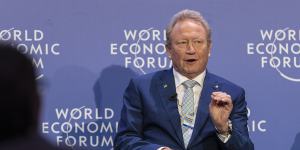It manufactures and sells top-selling brands like Sukin through Chemist Warehouse,Coles and Woolworths,as well as Zoe Foster Blake’s online juggernaut Go-To.

Zoe Foster Blake sold 50.1 per cent of her Go-To skincare business to BWX for $89 million.Kristoffer Paulsen
On Monday,BWX reported that it lost more than $100 million in the first half of the financial year after slashing asset valuations,while sales revenue plunged below $80 million. It faces financial collapse this month if it fails to come to terms with its bank.
The BWX shareholder meeting,which began just after the results were released,lasted just 12 minutes and 39 seconds without a single question being asked.
There was not even a query about the bruising downgrade of both sales and earnings,among other problems,which underlined the prognosis of the company’s auditors that there was material uncertainty that the group could trade its way out of trouble.
Mind you,there was a lot for investors to take in. Shareholders were greeted by their chairman Steve Fisher,who joined the board just before Christmas.
The newly appointed CEO,Rory Gration,who was due to hold his first AGM,was dumped that morning.
In his stead,Fisher unveiled the new CEO,former Coles executive Thinus Keeve. He was backed up by a chief finance officer who only joined the company in October – as a finance executive.
This trio has to come to terms with BWX’s bank this month – which had been forced to lend it fresh funds and agree not to act on loan breaches in December – or face the collapse of the business.
It is why BWX – worth as much as $750 million as recently as 2021 when it paid $89 million for 51 per cent of Foster Blake’s Go-To – is currently valued at just $36 million.

The latest financial accounts indicate that the BWX deal valued Go-To at $73 million more than it is now worth.
It is one of the reasons why BWX reported a $335 million loss last financial year as the company slashed the valuation of businesses acquired in a buying spree by previous management.
Go-To is not the only celebrity venture that has created problems. Purely Byron,the joint venture with Chris Hemsworth’s model/actor wife Elsa Pataky,suffered a $2.8 million writedown for the December half year.
With so many fresh faces on board,it was Fisher who was forced to acknowledge the mess presented to shareholders on Monday.
“I realise this has frustrated you and caused considerable concern,” the chairman said.
He was largely referring to the disasters of 2022. This included a four-month suspension from trading on the ASX while the company worked through erroneous financial statements from the previous year. There was also the discontinuation of its practice of channel stuffing,which threatened to financially unravel the group in July before billionaire Andrew Forrest helped rescue the group.
Channel stuffing is where retailers inflate sales by “selling” more products to their distributors than they can readily sell to consumers. Unwinding the excess inventory in warehouses across Australia and the United States was another contributor to BWX’s financial woes.
“As independent chairman,I would like to assure shareholders that we have spent considerable time reviewing the events that led to the problems that the company faced in financial year 22. It’s my intention to make sure these events do not occur in the future,” Fisher said.
But new problems have emerged as a result of cash constraints that forced BWS to seek further debt funding. In a tour de force of “retail speak”,Fisher revealed BWX had got itself into quite an unusual pickle.
These problems included “customers destocking key channels,cash constraints leading to out-of-stock as well as the effect of promotional campaigns which continued in channels even where the destocking occurred”,Fisher told investors.
Translated,this means BWX suffered from its retailers having to sell the backlog of goods in their distribution centres,which meant it did not get any fresh cash for these already paid-for sales,but it still had to fork out cash to promote them. This helped create a cash shortage,which meant it did not have the money to produce enough of the goods that would have brought money through the door.
“The cash constraints affected raw material purchases as well as promotional and marketing programs in other channels,which in turn impacted sales results as some of our key selling lines were not able to be replenished in a timely manner,” the company explained in its accounts.
Iconic duo front Tourism Australia campaign,
Foster Blake’s Go-To declined to comment,and would not say if it had been affected by product shortages.
BWX declined to clarify the issue further.
The cash shortage also cruelled its ability to pay creditors on normal terms – as its financial accounts also spelt out. This is another issue that raises doubts about its ability to trade out of trouble.
The $23 million emergency capital raising last June was not enough to cope with these new problems.
“The ability of the group to continue as a going concern is dependent on its ability to generate sufficient funds from its operating activities,to secure additional debt financing as required,to operate within the requirements of its banking facilities and have the ongoing support of its bankers or other financiers. In addition,there is a need for asset sales in the near term as well as the continued support of creditors,” the company said in its half-year report.

Andrew Forrest’s investment vehicle Tattarang swooped in on BWX last June.Faruk Pinjo
If there is any good news for investors who have watched the share price plunge from above the $5 mark to below 20¢ this week,it is that the current management team are confident they can still turn things around.
“I wouldn’t be here if I didn’t think I could get us to a much better place. I have a firm belief in the company and its recovery,” Keeve said in the only public statement since taking on the new role this week. He would not comment further.
His freshly appointed chairman remains confident as well.
“I believe that our brands are strong and supported by leading retailers and the product is desired by the consumer. With a new board,refreshed management team and focus placed on the core business,the company is well placed to return to profitability,” Fisher said.
No analysts or investors would go on the record with a view on whether this confidence was misplaced. But the only view which matters is that of billionaire Andrew Forrest and his private investment group,Tattarang.

Forrest swooped in at the worst possible time last June,acquiring in BWX for $30 million – or $1.10 a share. Barely a week later,BWX announced a massively dilutive equity raising at 60¢ a share to raise $23 million of desperately needed cash and a board-renewal process.
All up,Forrest spent about $36 million on a 20 per cent stake in BWX,which is now worth about $7 million.
Tattarang declined to comment but has privately expressed support for the clean sweep of BWX’s board and executive suite over the past six months.
The big question is whether Tattarang would step in if the Commonwealth Bank,and other financiers,baulk at the necessary financial support for BWX.
Funding the business through its cash constraints is only half the problem. Next year,Foster Blake has the option to sell the remaining 49 per cent to Go-To to BWX for $59 million – or more,if the business performs better than expected.
BWX might want to introduce Forrest to the skincare range.
The Morning Edition newsletter is our guide to the day’s most important and interesting stories,analysis and insights..